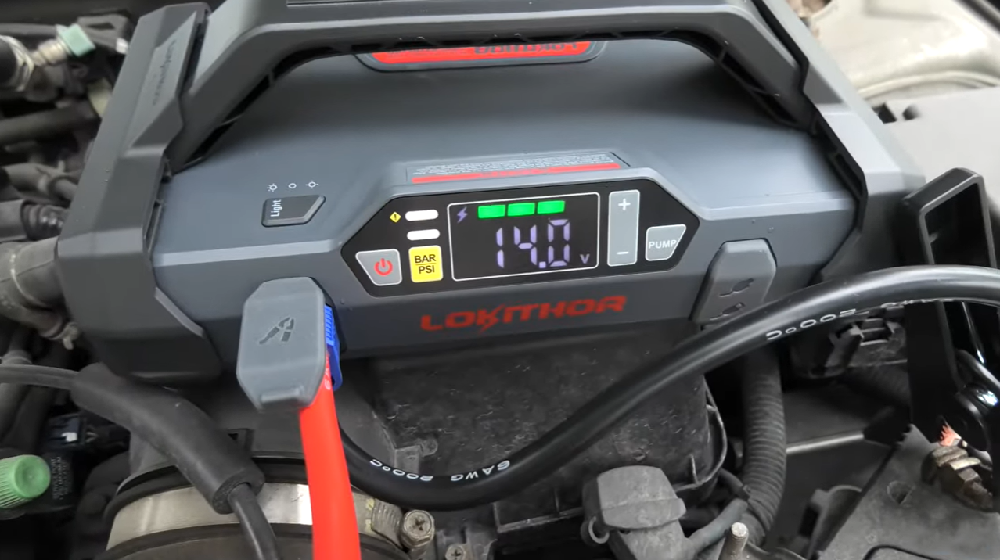A dead or discharged car battery is a very common issue, especially in the winter when your vehicle’s battery is working extra hard to power your car, wipers, lights, and electronics.
When faced with a dead or failing battery, a car battery charger or a jump starter can get you back on the road, however, each of these devices has its advantages, limitations, and purpose to consider.
Drivers often get confused between these two devices or simply think that they are the same but in fact, besides helping get your car started, they are quite different.
After reading this resource, you’ll understand the difference between a car battery charger and a jump starter, how they work and the pros and cons of each device.

What Is a Charger?
In order to comprehend the concept of a charger, all you have to do is refer to any other charger for any other device. For example, once your phone battery dies, the first thing you will do is plug it in. The same rule applies to car batteries as well. However, these devices convert household electricity to 12V DC which is important because, as you can tell, they have to be plugged into a wall socket at all times. Every unit has a different estimated time of fully recharging a battery, and it depends on its overall output. The higher the output, the less time it needs to go through a complete recharge cycle. However, the price also scales with the increase of the output power meaning that it costs more if you’re aiming for more amps and faster cycles.
There are many types of chargers on the market, but the top used ones are automatic. That means they shut off once the recharge cycle is complete and thus save power and prevent potential damage. In conclusion, a charger is a device that requires time to recharge a battery and delivers a steady flow of current.

What Is a Jump Starter?
The semi truck jump starter delivers an instant power signal which is supposed to kick-start a battery. These devices have notably higher output in comparison to chargers but lack the consistency. That is why there is a term “Peak” in this industry. It marks the highest possible amperage a particular unit can output. However, that doesn’t mean it’s consistently delivering the max output. In fact, most manufacturers point out the number of “cranks” within the peak power. In most cases, the number of cranks depends on the quality of the device’s battery.
Instead of relying on household electricity, jumpers have dedicated batteries. As expected, the quality of this component has a massive impact on the overall price of the product. Furthermore, jumpers can be used for a variety of other things whereas chargers only perform one operation. Many jump starters heavy duty come equipped with quite a bit of additional features such as LED, USB, micro USB, and etcetera. Therefore, you can use them as an emergency backup for almost all smart devices that you own. It’s also quite convenient because most models come with a visually appealing design and in small dimensions. One can carry their device in their car’s glove compartment at all times and use it in times of need, especially if you’re on the highway, traveling, or camping.

What is the difference between a car battery charger and a portable jump starter?
| Car Battery Charger vs Jump Starter | Car Battery Charger | Jump Starter |
| Purpose | Charging battery | Jump starting battery |
| Best for | Maintenance | Emergency situations |
| Charge Time | 24 to 48 hours | Instant |
| Jump Start Battery | NO | YES |
| Charges/Recharges Battery | YES | NO |
| Overcharge risk | YES | NO |
| Portable | YES | YES |
| Wireless/Cordless | NO | YES |
| Requires electrical outlet | YES | NO |
| Where to use | Home | Anywhere |
| Multifunction | NO | YES |
| Key functions | Recharge battery | Kick-start vehicle, USB charging, flashlight |
| Lifespan | Long | Long |
| Weight | Medium to heavy | Very light to medium |
| Key shopping factors | Amps and voltage | Peak current, battery capacity, (cold) cranking amps |
| Price | $$-$$$$ | $-$$$ |

Advantages and Disadvantages
Chargers
Pro:
It’s a convenient thing to have because you can always guarantee that your battery is fully charged. For example, if you have a faulty alternator in your car, the battery booster jump starter will help you but only to a certain extent. If the alternator doesn’t automatically charge the battery while the car is in motion, you’ll have to use the jumper once again when you turn the car off and wish to restart it. However, a charger eliminates this problem as it fully recharges the battery and lets you restart the car numerous times before the next cycle.
Cons:
When it comes to the shortcomings, the price is the biggest factor that separates these from jumpers. They tend to have a bigger price in comparison to starters, and as we said, the more output you require, the heftier the price. However, there are a couple of budget-friendly models out there that we have covered in some of our reviews. The lack of portability can also be considered a disadvantage. While it’s not deal-breaking by any means, some people greatly appreciate portability because they are frequently on the move. Another downside is the fact that it usually takes 10 to 12 hours for a full recharge cycle. Therefore, these devices aren’t supposed to be used for emergencies due to the obvious limitations. It is a great thing to have in the corner of your garage, but it’s not something you should reach for in case of an emergency.

Jump Starters
Pro:
Compactness and convenience are two main things most people look for in these units. Some models are small enough to fit one’s pocket and act as a substitute power station for anything including charging smart devices, illuminating dim areas, and etcetera. In fact, anything that requires a 12V connection can be recharged with an average jumper. Kick-starting a car will get you back on the road almost instantly whereas you can’t count on that with a charger. The high output makes the battery usable immediately which is also a great upside in comparison to waiting for several hours, especially if you’re in a hurry. Most people think about these devices as boosters, which is a pretty close representation of their whole purpose.
Cons:
While they are portable, they definitely are not lightweight. Some models tend to weigh quite a lot and it can be a burden, especially if you’re often on the move. On the other hand, some models are quite lightweight, but they lack output power and additional features. The size of the jumper’s battery is proportional to the power output. That means the more powerful a model is, the bulkier it gets. In case you own a particularly demanding car you might have to opt for the bulkier solution which isn’t always a pleasant one. It all comes down to personal preferences, but most people prefer compact units over cumbersome devices. While the additional features come in handy, they also tend to draw a lot of power thus decrease the peak amperage.

When To Use Car Battery Charger
A car battery charger is ideal to maintain a car’s battery charge on a vehicle that is stored away or for a vehicle with a weak battery, for example. If your car battery is consistently failing and discharged, it is likely time to replace it altogether.
Since car battery chargers normally take several hours to charge a battery, they are not ideal for emergency or time-sensitive situations like when your car won’t start in the morning before work. This is usually due to cold weather or leaving something on in your car that drained the battery overnight.
In these situations, a car battery starter portable, jumper cables or a roadside assistance service is your best bet. Continue reading to learn more about how jump starters work and when to use one.
When To Use Jump Starters
A rugged jump starter is the perfect car accessory to get you back on the road when faced with a dead car battery on the go, in a time-sensitive or emergency situation. These devices are very small and lightweight, so you can store them under your seat, in your glove box or in the trunk of your car.
Being multifunction devices, heavy truck jump starters can be used in a wide range of situations. For example, you can use them to charge your electronics on the go thanks to their USB charging ports or you can take advantage of their powerful LED flashlights when you need some extra light while on the road.
Check out our article on How Many Voltages Should A Car Battery Have?

Which One Should I Get?
Your decision should depend on your expectations and requirements. There is no definite winner because these units don’t share the same concept, ease of use, design, nor value. However, some of the good guidelines you should use are written in this article. For example, if you’re looking to fully recharge your battery at all times, opt for a charger. In case you’re having troubles starting your car in the morning, or during cold weather, a jumper might be a better solution as it solves the predicament instantly instead of over the course of a couple of hours.
Another thing you should consider is the price difference between these two products. If you’re on a tight budget and in need of a fast solution, make sure you make the right one or else it can backfire pretty quickly.
Frequently Asked Questions (FAQ)
Can you use a battery charger jumpstart a car?
A battery charger cannot be used to jumpstart a car. It can only be used to recharge a car battery, which typically takes from a few hours to several days depending on the size of the battery and the power of the car charger being used.
Can a portable jump starter charge a battery?
A small battery jump starter cannot charge a battery. It is designed to give an instant powerful flow of current sufficient to get the battery working, after which the vehicle’s alternator proceeds to actually charge the battery.
Can you charge a car battery while it is still connected?
Yes, a car battery can be charged using a car battery charger while still connected to a car. It can also be charged if disconnected from the vehicle.
Can you charge a car battery without removing it?
Yes, a car battery can be charged using a car battery charger without removing the battery from the car. It can also be charged if removed from the vehicle.

Can you leave a car battery charger on overnight?
This depends on your car battery and the charging device as you may risk overcharging your battery. Some batteries have the technology to handle overcharging while others do not. Some premium car battery chargers turn off automatically once the battery is fully charged or reduce the supply of current to maintain a charge once full.
Can I start my car while my battery is charging?
Yes, a car can be turned on while the battery is charging.
What happens if you leave a car battery charger on too long?
This depends on the car battery and the car battery charger that is being used.
Some batteries can handle overcharging while others cannot. Batteries that cannot handle overcharging risk permanent damage and in some extreme cases may explode.
Certain car battery chargers turn off automatically once the battery is fully charged and/or reduce the supply of current to maintain a charge once full. When using one of these chargers, nothing risks happening if you leave your car battery charger on past a full charge.
How long does it take to charge my car battery?
The time it takes to charge a car battery depends on the size of the battery and the power of the car battery charger. You simply divide the battery’s amp rating by the car battery charger’s amp-hour rating to see how many hours it would take to fully charge a battery.
For example, a normal 48 amp car battery would take 24 hours to charge using a 2 amp-hour car battery charger (48 / 2 = 24).
Contact Us
For further product information, please visit:
- Official website: https://www.lokithorshop.com/
- Facebook: https://www.facebook.com/Lokithorshop/
- Email address: info@lokithorshop.com




Leave a comment
All comments are moderated before being published.
This site is protected by hCaptcha and the hCaptcha Privacy Policy and Terms of Service apply.